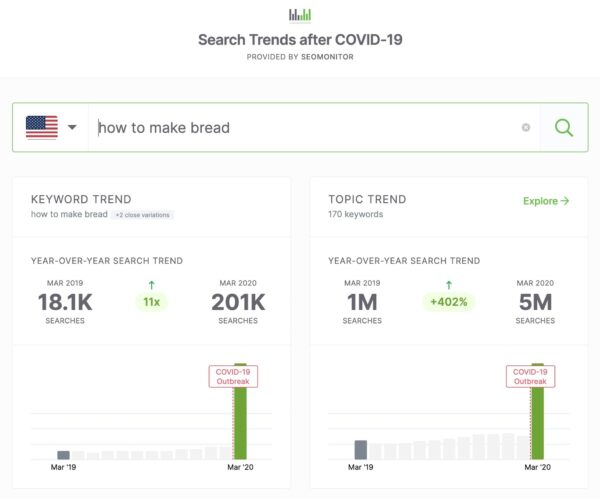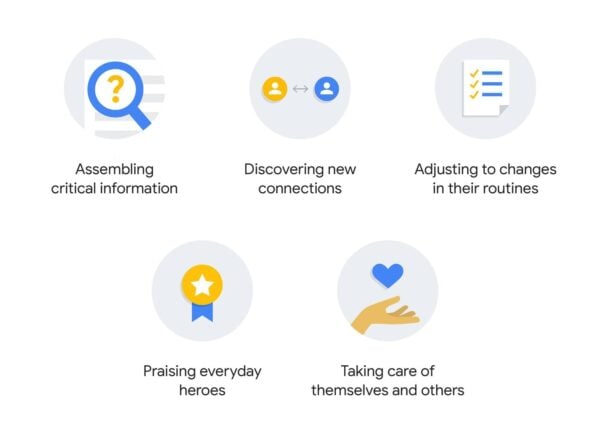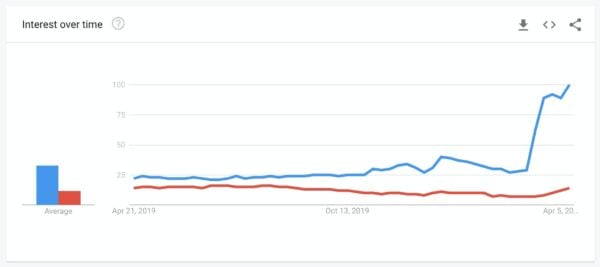Adapting your content strategy to changing times

We don’t have to remind you of the drastic changes that are happening in the world. There’s a good chance that these changes impact how you do business. But they also bring opportunities. While people are stuck at home, they spend a lot of time online. And they behave differently — they search differently and have different needs. If you have a content strategy for your site, now might be a good time to go back and see how you can adopt these new insights. And with it, find new ways to get your message across in a way that is not considered out of place or tone-deaf. Here are a couple of pointers to help you with adapting your content strategy to changing times.
What’s happening?
It’s a bit hard to write a piece about dealing with a crisis without falling into the trap of terribly cliched language. “Unprecedented, never seen anything like it, bizarre, unreal, et cetera, et cetera.” Everyone knows we are “living in difficult times” and that “we’re doing our utmost best to overcome this crisis.” Yes, we are. You are. We all are. Language plays an important part in the way you handle this crisis and the way your — potential — customer sees you.
Continuing your regular hard-hitting campaigns might backfire. It’s not business as usual, so to say. You do have to show compassion, and you do have to be mindful of what you want to say and how you want to say this.
During this Coronavirus pandemic, many things have changed. There are probably more changes around the corner. And if we look at the future, things might not be the same as they were. The world has changed — and we all have to go along with it.
People change during a crisis
People change during uncertain times, that’s a fact. How people change is most likely to accelerate during a crisis. Today, a lot of people are uncertain about their future and health. Keeping this in mind, it is not strange to see that people’s needs also change. Food and healthcare jump to the top, while other wants and needs like traveling or going to a restaurant are out of the question.
This behavior translates to the online world. While you see people lining up to get their groceries in stores, they also line up online to get a delivery time slot for their local supermarket. Traffic to online stores selling essential items and food has surged, while other markets and industries plummeted. For instance, while the travel industry tanked, the home improvement and home fitness markets exploded.

As the behavior of people changes, it doesn’t change for everyone and every industry in the same way. Some win, some lose. While everyone is adapting to this new reality, there might be new opportunities for your business to be found.
Concerns, needs and search behavior
While we’re trying to keep occupied by Netflix, Facebook, and YouTube, it’s also pretty obvious that many people have concerns. Just go to Google Coronavirus Search Trends dashboard and see what people are looking for:
- How to make a face mask?
- Where’s my stimulus money?
- When will everything go back to normal?
- How long until 2020 ends?
Yes, that last one was a trending search in the US at the time of writing this article. But seriously, as a content creator, you need to be aware of these changes and adapt your content if needed.
There are a lot of sources that look into how people are adapting to this situation, like these Coronavirus insights from Google.

More internet usage at different times
With everyone at home, internet usage is up as well. For many people, life has moved online. Not only do social media platforms report surges in usage, but many sites and apps as well. New tools to work from home pop up quickly, while existing ones reach huge audiences overnight.
Changes in human online behavior lead to new online habits. It might be that traffic to your site has changed — it may not simply have gone up or down, but perhaps it comes from different devices, keyphrases or at different times. It might also mean your audience is less or more focused and maybe more eager to get your products or services. This all influences how you previously thought everything worked.
For instance, when we look at traffic for yoast.com our total traffic has gone up. We never had a huge amount of mobile users, but in the past couple of weeks, their number grew as well. In addition, we have more traffic coming in on the weekends. Our audience is used to visiting our site during ‘office hours’, but we see a pretty big move towards the weekends. It could be that our audience is getting some extra work done on the weekends, or it might simply be a result of the overall boost in traffic we had. Something we have to dive into. With enough insights, we can make adjustments to our content strategy.
What can you do to adapt your content strategy?
Would you like to simply drop everything, hide under a table and wait for these months to end? I understand, I really do. But that doesn’t help. It is ok for you to keep your regular content going, but be sure to think about the message and tone. Other carefully crafted campaigns might have gone down the toilet and you need to accept that. It might also be that you’re not tanking but soaring, which brings a whole new set of challenges. There are, however, things you can do right now to re-align your content with the times.
So, don’t blindly drop everything, but make educated guesses on what content works and what doesn’t. Dive into the research to find out where you can double down and where you should change the focus. Try to find a way to look over the horizon and get a sense of where your business or market is going. And keep a close eye on your campaigns and make adjustments accordingly.
Today, it’s a good idea to ask yourself: who am I and who do I want to be? Can I hold this course or do I need to pivot? How do I add value and does this value align with what people truly want right now? If you’re not comfortable with what you’re doing, you should change it up.
In general, these are the times that SEO can prove its worth. Don’t just focus on content, but invest in all-round SEO. Improve your site. Get those technical issues fixed, work on the site speed and build a solid site structure. All this can help you get back on top when — if — the world gets back to normal. Our temporarily free All-around SEO training can help you get started! We’ve waived the cost of this interactive course during this pandemic.
Read more: 4 tips to quickly improve your site in the current situation »
Do your research
It is very important to open Google Analytics, Search Console and maybe some third-party SEO tools and dive into the data. There are important clues to be had about the direction you should take your content strategy. What do the numbers say? Is your recent content doing awful or better than ever? Are there new search terms popping up in Google Search Console? What does your Google Trends look like?
Keyword research is one of the key ingredients in a successful content strategy. Now that you know that people’s online behavior is changing during these times, it’s a good idea to redo that keyword research. In fact, it’s always important to redo this research on a regular basis. But when you’re changing or adapting your content strategy, this is essential.
The same goes for search intent research. You can even ask your customers how they’d like to keep in touch and what kind of content they’d like to see. It might be that your customer is no longer in a buying mood or it takes them longer to get there. This might mean you need to change the content to match an updated user journey. In this regard, you should also keep a close eye on the SERPs. Check up on your terms, notice the changes and jump on any realistic chance you see.
Also, read up on the research other organizations are doing. Keep tabs on the larger trends to see if you can find new ways of adapting your content to changes in behavior.
Adapt your tone
Finding the right tone is not always easy. It’s hard enough to develop your own tone of voice without having a crisis weighing down on you. People will look more critically at what you are doing and what you are saying. That’s not always a bad thing, of course, but it can be hard to please everyone. Not everyone reads a message the same way. Some think you shouldn’t put out anything at all, because they think you’re exploiting the situation. Others value what you do or welcome your content to help take their mind off things.
If you can, keep your content going. Don’t throw everything overboard, but be mindful. Listen to your customers and care for them. Make sure that what you do is real and fitting of you and your company.
Adapt your message
Adapting your tone inevitably also means adapting your message. You have to think carefully about what you want to communicate. Ask yourself, does your service or product still align with what people want? Priorities shift and it might be that your customers need something different from you. Also, ask yourself if you’re really adding something to the world if you’re thinking about publishing COVID-19 content.
The world used to revolve around getting conversions. Getting that newsletter sign up, making people buy your product or try your course. Now, it is probably more important to get noticed in the first place. Become top of mind because of the social work your brand does or how you try to make this world a better place.
Use social media to reach out to your customer with caring messages, without being too cliched — remember the intro of this article? Find out which type of content people are looking for. We, for one, have noticed a lot of interest in how-to content, so it could be a good idea to invest in video explainers. Or maybe you could try and answer more questions, with an FAQ for instance. Of course, your research will give you an idea of what to focus on.
Essential tools
These days, you should live in Google Trends. Exciting things are happening almost in realtime. Of course, Google Analytics will show you everything you need to know about people who visited your site, while Search Console also gives you insights about people who searched but didn’t end up on your site. SEO tools like SEMrush, Ahrefs and Ryte also give you a ton of information about what’s going on and off your site. Use Q&A tools like Answer the Public and AlsoAsked.com to find new questions to answer.
A special mention goes to SEOMonitor for their awesome Search Trends after COVID-19 tracker.

Start adapting your content strategy
It’s hard to predict when everything is getting back to normal. It might take some time and the world is bound to change in the meantime. So, when looking at your content strategy it’s important to align this with the current situation. Find out if you can help your customers or if you can reach them in other ways. Make sure your message is on point and caring. Don’t scream BUY BUY BUY. It’s okay to sell stuff, but try to keep it genuine.
Stay safe and good luck!
Keep reading: Articles on SEO Copywriting »


Discussion (8)